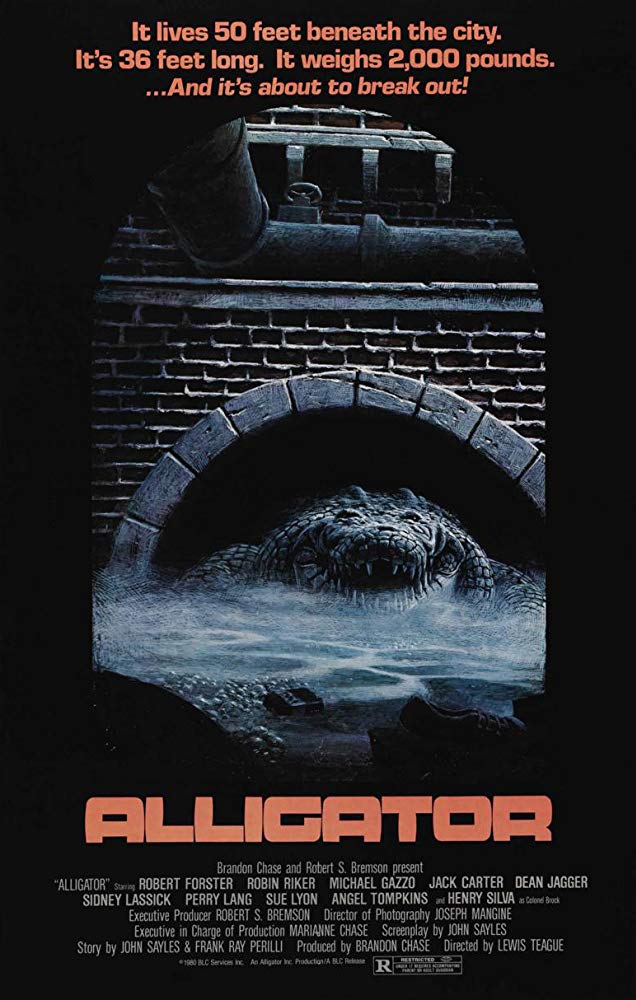Previous FilmAll Monsters Attack
Next FilmAlligator II The Mutation
Alligator 1980
 | A baby alligator is flushed down a Chicago toilet and survives by eating discarded laboratory rats injected with growth hormones. The small reptile grows gigantic, escapes the city sewers, and goes on a rampage. |
The Cast
| Robert Forster | - | David |
| Robin Riker | - | Marisa |
| Michael V. Gazzo | - | Chief Clark |
| Dean Jagger | - | Slade |
| Sydney Lassick | - | Gutchel |
| Jack Carter | - | Mayor |
| Perry Lang | - | Kelly |
| Henry Silva | - | Brock |
Film Trivia
The oft-malfunctioning animatronic alligator used in the film was later donated to the Florida Gators as a team mascot. Ramon made several appearances before games and during halftime.
Robert Forster improvised the jokes in regard to his receding hairline, which a delighted John Sayles wrote into the script during shooting for the other characters.
The shot of the swat team emerging from the sewers looked so real that people actually thought they were terrorists and some even called the police.
John Sayles read Frank Ray Perilli's script for the film once and then totally scrapped it. Sayles said it was set in Milwaukee and explained that the alligator grew gigantic because of beer from a beer factory going into the sewers.
The first victim's name is Edward Norton. The Honeymooners (1955) features a sewer worker of that name.
As in the shooting of this film's main inspiration, Jaws (1975), the mechanical, giant alligator was often malfunctioning. In a few scenes, Lewis Teague either shot around the alligator to build suspense or shot a regular alligator in miniature sets (which is plainly obvious in some shots).
According to director Lewis Teague the film was supposed to be scored by James Horner who actually wrote a full score. However due to some sort of a strike he could not record his score so he was replaced by another composer.
Robert Forster was recovering from a case of spinal meningitis when principle filming began.
Actor Bryan Cranston worked on the movie has a production assistant for the Special effects department.
Screenwriter John Sayles also wrote Roger Corman's Battle Beyond the Stars (1980), released the same year as Alligator. During this period, Sayles wrote the first draft of a script for Steven Spielberg known as "Night Skies," which was never made but helped inspire E.T. the Extra-Terrestrial (1982) (which includes a mention about "alligators in the sewers", coincidentally).
The proceeds that John Sayles earned from his screenwriting duties were used to finance Return of the Secaucus Seven (1979).
Joe Dante was offered to direct the film.
The final cinema film of Dean Jagger.
Kelly (played by Perry Lang), the young police officer who follows David through the sewers, is always seen with chewing tobacco in his mouth.
Marisa never encounters the alligator/Ramon.
Colonel Brock says to Marissa about the alligator "if I get myself killed chasing it what fun would it be" foreshadowing his own death when Ramon eats him in an alley.
Colonel Brocks rifle is a Remington Model 7600 with a telescopic scope.
Davids revolver is a stainless snub-nosed Smith & Wesson 36.
As of 2018, Sue Lyon's final acting appearance.
In the prologue showing young Marisa and her baby alligator at home: in order to set the time period, news on the radio mentions riots of the 1968 Democratic Convention... Robert Forster starred in Medium Cool that same year, 1968, which centered on and around the riots.
The little girl from the beginning of the movie, billed as Young Marissa and played by Leslie Brown, is herpetologist and Forster's love interest Marisa as a child. Her pet baby alligator, whom she named Ramon, is the giant man-eating alligator as a youngling. In an ironic example of a Butterfly Effect Theory, if her dad had let her keep the alligator, she and Forster's character would probably never have met.
In the scene in the sewers where young officer Kelly sneaks up on Forster as a prank, the two take a look at the map and just at that moment, one of their flashlights shines on the area behind them for barely a second showing the audience that the alligator is standing on a platform behind them.